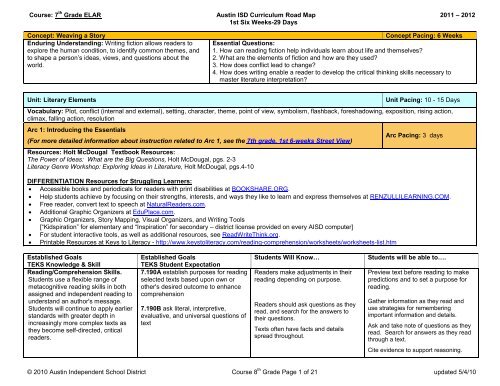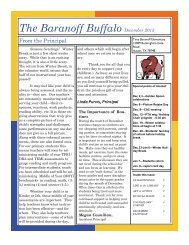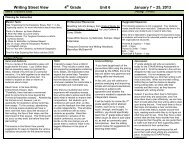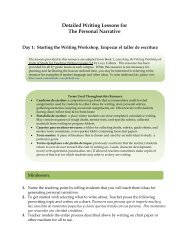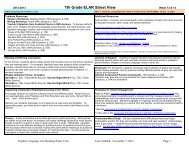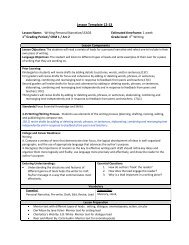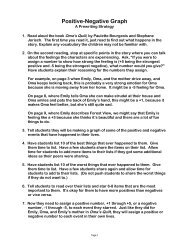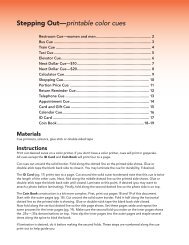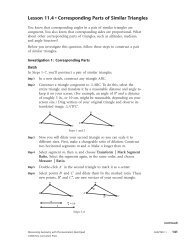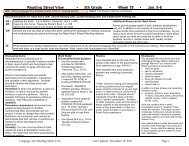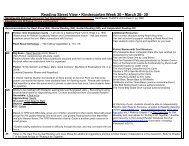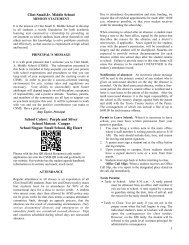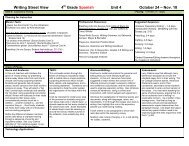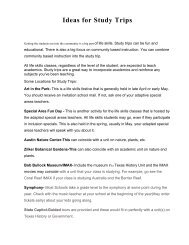MATRIX # - Austin ISD
MATRIX # - Austin ISD
MATRIX # - Austin ISD
You also want an ePaper? Increase the reach of your titles
YUMPU automatically turns print PDFs into web optimized ePapers that Google loves.
Course: 7 th Grade ELAR <strong>Austin</strong> <strong>ISD</strong> Curriculum Road Map 2011 – 2012<br />
1st Six Weeks-29 Days<br />
Concept: Weaving a Story<br />
Enduring Understanding: Writing fiction allows readers to<br />
explore the human condition, to identify common themes, and<br />
to shape a person’s ideas, views, and questions about the<br />
world.<br />
Concept Pacing: 6 Weeks<br />
Essential Questions:<br />
1. How can reading fiction help individuals learn about life and themselves<br />
2. What are the elements of fiction and how are they used<br />
3. How does conflict lead to change<br />
4. How does writing enable a reader to develop the critical thinking skills necessary to<br />
master literature interpretation<br />
Unit: Literary Elements<br />
Unit Pacing: 10 - 15 Days<br />
Vocabulary: Plot, conflict (internal and external), setting, character, theme, point of view, symbolism, flashback, foreshadowing, exposition, rising action,<br />
climax, falling action, resolution<br />
Arc 1: Introducing the Essentials<br />
(For more detailed information about instruction related to Arc 1, see the 7th grade, 1st 6-weeks Street View)<br />
Resources: Holt McDougal Textbook Resources:<br />
The Power of Ideas: What are the Big Questions, Holt McDougal, pgs. 2-3<br />
Literacy Genre Workshop: Exploring Ideas in Literature, Holt McDougal, pgs.4-10<br />
Arc Pacing: 3 days<br />
DIFFERENTIATION Resources for Struggling Learners:<br />
• Accessible books and periodicals for readers with print disabilities at BOOKSHARE.ORG.<br />
• Help students achieve by focusing on their strengths, interests, and ways they like to learn and express themselves at RENZULLILEARNING.COM.<br />
• Free reader, convert text to speech at NaturalReaders.com.<br />
• Additional Graphic Organizers at EduPlace.com.<br />
• Graphic Organizers, Story Mapping, Visual Organizers, and Writing Tools<br />
[“Kidspiration” for elementary and “Inspiration” for secondary – district license provided on every A<strong>ISD</strong> computer]<br />
• For student interactive tools, as well as additional resources, see ReadWriteThink.org.<br />
• Printable Resources at Keys to Literacy - http://www.keystoliteracy.com/reading-comprehension/worksheets/worksheets-list.htm<br />
Established Goals<br />
TEKS Knowledge & Skill<br />
Reading/Comprehension Skills.<br />
Students use a flexible range of<br />
metacognitive reading skills in both<br />
assigned and independent reading to<br />
understand an author's message.<br />
Students will continue to apply earlier<br />
standards with greater depth in<br />
increasingly more complex texts as<br />
they become self-directed, critical<br />
readers.<br />
Established Goals<br />
TEKS Student Expectation<br />
7.190A establish purposes for reading<br />
selected texts based upon own or<br />
other's desired outcome to enhance<br />
comprehension<br />
7.190B ask literal, interpretive,<br />
evaluative, and universal questions of<br />
text<br />
Students Will Know…<br />
Readers make adjustments in their<br />
reading depending on purpose.<br />
Readers should ask questions as they<br />
read, and search for the answers to<br />
their questions.<br />
Texts often have facts and details<br />
spread throughout.<br />
Students will be able to….<br />
Preview text before reading to make<br />
predictions and to set a purpose for<br />
reading.<br />
Gather information as they read and<br />
use strategies for remembering<br />
important information and details.<br />
Ask and take note of questions as they<br />
read. Search for answers as they read<br />
through a text.<br />
Cite evidence to support reasoning.<br />
© 2010 <strong>Austin</strong> Independent School District Course 8 th Grade Page 1 of 21 updated 5/4/10
Course: 7 th Grade ELAR <strong>Austin</strong> <strong>ISD</strong> Curriculum Road Map 2011 – 2012<br />
1st Six Weeks-29 Days<br />
7.190C monitor and adjust<br />
comprehension (e.g., using<br />
background knowledge; creating<br />
sensory images; rereading a portion<br />
aloud; generating questions).<br />
There are a variety of strategies<br />
readers can use to support reading<br />
comprehension.<br />
Key Terms: metacognitive, monitor,<br />
background knowledge, sensory<br />
images, adjust, details, purpose<br />
Use sophisticated vocabulary such as:<br />
facts, details, strategy, evidence.<br />
Know when meaning is breaking<br />
down and use strategies to help<br />
rebuild and clarify meaning.<br />
ELPS: 2E Listening, 3F Speaking,<br />
3H Speaking, 4J Reading, K<br />
Reading<br />
Reading/Vocabulary Development.<br />
Students understand new vocabulary<br />
and use it when reading and writing.<br />
7.2A determine the meaning of<br />
grade-level academic English<br />
words derived from Latin, Greek, or<br />
other linguistic roots and affixes,<br />
7.2B use context (within a sentence<br />
and in larger sections of text) to<br />
determine or clarify the meaning of<br />
unfamiliar or ambiguous words<br />
RC1;<br />
7.2E use a dictionary, a glossary,<br />
or a thesaurus (printed or<br />
electronic) to determine the<br />
meanings, syllabication,<br />
pronunciations, alternate word<br />
choices, and parts of speech of<br />
words RC1.<br />
Context (syntax) provides information<br />
about the meaning of unknown words.<br />
Words that have similar parts often<br />
have similar meanings (e.g. popular &<br />
population)<br />
Often there are clues about the<br />
meaning of the word that can be<br />
found in the surrounding sentences.<br />
These clues take the form of<br />
synonyms, antonyms, explanation,<br />
restatement, examples, & definition.<br />
(see Powerpoint on Context Clues)<br />
Most words have multiple meanings<br />
and have different forms for different<br />
parts of speech.<br />
Which reference materials are<br />
appropriate to address specific needs.<br />
Examine the parts of unknown words<br />
to look for clues about the meaning of<br />
the word.<br />
Look for clue words in the text<br />
surrounding an unknown word to<br />
determine the meaning of an<br />
unknown word.<br />
Be able to define what type of clue is<br />
available (synonyms, antonyms,<br />
explanation, restatement, examples,<br />
or definition).<br />
Use dictionary definitions to<br />
determine exactly which meaning of a<br />
word is intended by the author.<br />
Use resources such as a thesaurus or<br />
software to understand the nuances<br />
and connotations of words.<br />
Key Terms: suffix, prefix, root word,<br />
base word, reference, dictionary,<br />
thesaurus, glossary, context, part-ofspeech,<br />
noun, verb, syntax, grammar,<br />
surrounding text, clarify, synonyms,<br />
antonyms, explanation, restatement,<br />
examples, definition, idioms,<br />
expressions, adage, figure of speech,<br />
figurative language, expressions,<br />
sayings, proverb, motto,<br />
Look for clue words and semantic<br />
information in the text surrounding an<br />
unknown word to determine the<br />
meaning of an idiom or expression.<br />
ELPS: 4C Reading, 4F Reading, 1B<br />
Learning, Strategies, 1D Learning<br />
Strategies, 1H Learning Strategies<br />
© 2010 <strong>Austin</strong> Independent School District Course 8 th Grade Page 2 of 21 updated 5/4/10
Course: 7 th Grade ELAR <strong>Austin</strong> <strong>ISD</strong> Curriculum Road Map 2011 – 2012<br />
1st Six Weeks-29 Days<br />
Reading/Comprehension of<br />
Literary Text/Poetry. Students<br />
understand, make inferences and<br />
draw conclusions about the structure<br />
and elements of poetry and provide<br />
evidence from text to support their<br />
understanding.<br />
Reading/Comprehension of<br />
Literary Text/Drama. Students<br />
understand, make inferences and<br />
draw conclusions about the structure<br />
and elements of drama and provide<br />
evidence from text to support their<br />
understanding.<br />
Reading/Comprehension of<br />
Literary Text/Fiction. Student<br />
understand, make inferences and<br />
draw conclusions about the structure<br />
and elements of fiction and provide<br />
evidence from text to support their<br />
understanding.<br />
Reading/Comprehension of<br />
Literary Text/Literary Nonfiction.<br />
Students understand, make<br />
inferences and draw conclusions<br />
about the varied structural patterns<br />
and features of literary nonfiction and<br />
respond by providing evidence from<br />
text to support their understanding.<br />
Writing/Writing Process. Students<br />
use elements of the writing process<br />
(planning, drafting, revising, editing,<br />
and publishing) to compose text.<br />
7.4 A analyze the importance of<br />
graphical elements (e.g., capital<br />
letters, line length, word position)<br />
on the meaning of a poem RC2.<br />
7.5 A explain a playwright's use of<br />
dialogue and stage directions RC2.<br />
7.6A explain the influence of the<br />
setting on plot development RC2;<br />
7.6B analyze the development of<br />
the plot through the internal and<br />
external responses of the<br />
characters, including their<br />
motivations and conflicts RC2;<br />
7.6C analyze different forms of<br />
point of view, including firstperson,<br />
third-person omniscient,<br />
and third-person limited RC2.<br />
7.7A describe the structural and<br />
substantive differences between an<br />
autobiography or a diary and a<br />
fictional adaptation of it RC1.<br />
7.14A plan a first draft by selecting a<br />
genre appropriate for conveying the<br />
intended meaning to an audience,<br />
determining appropriate topics through<br />
a range of strategies (e.g., discussion,<br />
background reading, personal interests,<br />
interviews), and developing a thesis or<br />
controlling idea;<br />
The structure and text features of<br />
poems.<br />
Playwrights use dialogue and stage<br />
directions to convey meaning in a<br />
drama.<br />
Setting is the time and place of the<br />
action.<br />
Plot is the series of events in a story.<br />
Plot usually centers on conflict, a<br />
struggle between different forces.<br />
Conflicts fuel the action, moving the<br />
plot forward. A conflict can be<br />
external (person vs. person or nature)<br />
or internal (conflict with self).<br />
Point of view is the way in which an<br />
author reveals his or her voice,<br />
through characters, events, and ideas<br />
told in a story.<br />
The difference between an<br />
autobiography or a diary and the<br />
fictional stories based on that<br />
autobiography or diary.<br />
Writing is a recursive process that<br />
includes planning or prewriting,<br />
drafting, revising, editing and<br />
publishing.<br />
Writers write best when choosing<br />
ideas they know and/or care a lot<br />
about.<br />
Analyze the ways in which poems are<br />
put together and use examples from<br />
the poem to explain their analysis.<br />
Analyze how the visual elements of a<br />
poem affect the poem’s meaning.<br />
ELPS: 4J Reading 4K Reading<br />
Understand and draw conclusions<br />
about the ways dramas are put<br />
together and support analysis with<br />
examples from the text.<br />
ELPS 4J Reading 3H Speaking<br />
Discuss how the place and time in<br />
which a story is set affect the way the<br />
story develops.<br />
Analyze plot development and how a<br />
character’s motives and conflicts<br />
(both within and outside of<br />
themselves) affect the way the story<br />
develops.<br />
Analyze the differences between the<br />
different points of view from which a<br />
story is told.<br />
ELPS: 4J Reading, 4K Reading<br />
Understand and draw conclusions<br />
about the different ways nonfiction<br />
texts are put together and support<br />
analysis with examples from the text.<br />
ELPS: 4J Reading, 4K Reading<br />
Create a first draft by determining<br />
what genre best fits the writing<br />
situation, using strategies to pick a<br />
topic for writing, and determining what<br />
the thesis or main idea will be.<br />
Organize drafts in different ways and<br />
develop ideas into well thought out<br />
pieces of writing.<br />
© 2010 <strong>Austin</strong> Independent School District Course 8 th Grade Page 3 of 21 updated 5/4/10
Course: 7 th Grade ELAR <strong>Austin</strong> <strong>ISD</strong> Curriculum Road Map 2011 – 2012<br />
1st Six Weeks-29 Days<br />
14B develop drafts by choosing an<br />
appropriate organizational strategy<br />
(e.g., sequence of events, causeeffect,<br />
compare-contrast) and<br />
building on ideas to create a<br />
focused, organized, and coherent<br />
piece of writing RC1;<br />
14C revise drafts to ensure precise<br />
word choice and vivid images;<br />
consistent point of view; use of<br />
simple, compound, and complex<br />
sentences; internal and external<br />
coherence; and the use of effective<br />
transitions after rethinking how<br />
well questions of purpose,<br />
audience, and genre have been<br />
addressed RC1/RC2;<br />
14D edit drafts for grammar,<br />
mechanics, and spelling RC1/RC3;<br />
It is helpful to get input and feedback<br />
from others at any stage of the writing<br />
process.<br />
Drafting is turning your ideas into a<br />
rough draft.<br />
When writers revise, they review a<br />
draft and look for ways to improve the<br />
ideas, style, and structure of the<br />
writing.<br />
Studying author's craft in mentor texts<br />
is a way to support revision.<br />
Editing is important so that all of the<br />
ideas and/or information can be<br />
understood by the reader.<br />
Revise drafts to improve the wording,<br />
maintain a consistent point of view,<br />
use a variety of sentence structures,<br />
maintain a sense of unity, and include<br />
effective transitions, after thinking<br />
through the purpose, audience, and<br />
genre of writing.<br />
Edit writing to correct mistakes in<br />
grammar, mechanics and spelling.<br />
Use the input from classmates and<br />
teacher to improve and publish a final<br />
draft.<br />
Utilize ideas presented in teacher's<br />
mini-lessons to revise and edit.<br />
ELPS: 1A Learning Strategies, 3G<br />
Speaking, 5B Writing, 5D Writing,<br />
4F Reading<br />
Listening and Speaking/Teamwork.<br />
Students work productively with<br />
others in teams. Students will<br />
continue to apply earlier standards<br />
with greater complexity.<br />
14E revise final draft in response to<br />
feedback from peers and teacher and<br />
publish written work for appropriate<br />
audiences.<br />
7.28A participate productively in<br />
discussions, plan agendas with clear<br />
goals and deadlines, set time limits<br />
for speakers, take notes, and vote on<br />
key issues.<br />
Working collaboratively with peers is<br />
a valuable skill that develops reading,<br />
writing, listening, and speaking skills.<br />
Work appropriately with teammates<br />
toward a common goal.<br />
Take leadership responsibility for<br />
some part of the collaborative work,<br />
and accept direction from peers<br />
taking leadership responsibility for<br />
other parts of the collaborative effort.<br />
ELPS: 1B Learning Strategies, 1G<br />
Learning Strategies, 2I Listening,<br />
3E Speaking<br />
In addition to the TEKS listed in this Arc, every week teachers should also provide rigorous and explicit instruction in the 7th grade Recurring TEKS:<br />
F19 (A-F) Comprehension Skills, 1(A) Fluency: Read aloud grade-level and instructional text, 2(A-E) Vocabulary,<br />
13(A-D) Comprehension of Media<br />
Mandated by Texas Administrative Code (19 TAC §74.4), the English Language Proficiency Standards (ELPS), present standards that outline the instruction<br />
school districts must provide to ELLs in order for them to have the full opportunity to learn English and to succeed academically. The rule also clarifies that the<br />
ELPS are to be implemented as an integral part of the instruction in each foundation and enrichment subject of the TEKS. Please review the standards at:<br />
http://ritter.tea.state.tx.us/rules/tac/chapter074/ch074a.html#74.4<br />
© 2010 <strong>Austin</strong> Independent School District Course 8 th Grade Page 4 of 21 updated 5/4/10
Course: 7 th Grade ELAR <strong>Austin</strong> <strong>ISD</strong> Curriculum Road Map 2011 – 2012<br />
1st Six Weeks-29 Days<br />
Performance Tasks<br />
Writing Process workshop (pg. 20-23)- 1 day Which essay is which After<br />
completing workshop, students are given four student-generated samples<br />
without scores. Each essay should have earned a different score: 1-4 based<br />
on the rubric, pg. 22). Students analyze the samples and decide which sample<br />
is the score point 1, 2, 3, and 4. Explain reasoning. Debate using accountable<br />
talk if time allows.<br />
STAAR Formative Writing Sample: (expository) Write a composition<br />
explaining why it is important to set goals for the future. (Or other teacher<br />
selected topic to get a baseline on students' writing.) (see Holt, pgs. TX60-61)<br />
Student Work Products/Assessment Evidence<br />
Other Evidence (i.e. unit tests, open ended exams, quiz, essay, student<br />
work samples, observations, etc.)<br />
Reader Response Notebooks (Teacher introduces and models how to write<br />
a response after reading aloud a text to students). Then ask students an<br />
open-ended question about the text and have students respond.<br />
Note Taking: Literary Genres Workshop (Resource Manager pg. 1-2). Model<br />
how to annotate using the first part of a text and a document handler. Have<br />
students practice with you for the middle part of the text and then allow them<br />
to continue independently on the last section of the text.<br />
STAAR Formative Writing Sample (personal narrative). Write a<br />
composition about trying to do something you thought was difficult.<br />
Select a piece of text for students to read and annotate (after modeling and<br />
practicing). Circulate the room, providing specific feedback. Afterwards,<br />
debrief and create a criteria chart with students on effective annotation<br />
strategies.<br />
DIFFERENTIATION for Struggling Learners [What/HOW/ASSESS]: After<br />
developing a topic map, students can use 2-Column notes format to gather<br />
and organize main ideas and details for their writing.<br />
http://www.keystoliteracy.com/reading-comprehension/worksheets/notetaking-worksheet.pdf<br />
© 2010 <strong>Austin</strong> Independent School District Course 8 th Grade Page 5 of 21 updated 5/4/10
Course: 7 th Grade ELAR <strong>Austin</strong> <strong>ISD</strong> Curriculum Road Map 2011 – 2012<br />
1st Six Weeks-29 Days<br />
Learning Plan<br />
Lesson/Activity/Module Name Teacher Resource Student Resource Technology (Media,<br />
website, etc.)<br />
Day 1 Classroom Routines<br />
Social Contracts (website). Explains the<br />
Social Contract for establishing beginning<br />
of the year expectations.<br />
For more detailed<br />
information about<br />
instruction related to Arc 1,<br />
see the 7th grade, 1st 6-<br />
weeks Street View<br />
Teacher-generated handouts<br />
Reader/Writer Notebook<br />
Teacher One Stop DVD-ROM<br />
Student One Stop DVD-ROM<br />
www.thinkcentral.com<br />
Other<br />
A<strong>ISD</strong> Code of<br />
Conduct<br />
Best Practices<br />
Toolkit<br />
• In each class period, students and<br />
teacher together generate list of<br />
how they want to be treated by<br />
each other<br />
• Teacher compiles the list into one<br />
to post permanently in the<br />
classroom.<br />
• Student and teacher also co-create<br />
a rubric to measure effective<br />
interaction in the classroom<br />
Literary Genres Workshop: Exploring<br />
Ideas in Literature<br />
Strategies That Work: Literature/Reading<br />
Strategies Workshop<br />
Academic Vocabulary: What is Academic<br />
Vocabulary<br />
Writing Process Workshop: Expressing<br />
Ideas in Writing<br />
Campus Student Rules &<br />
Expectations, Teacher-<br />
Established Classroom<br />
Rules & Expectations<br />
Holt McDougal TE, pgs. 4-<br />
10<br />
Holt McDougal TE, pgs.11-<br />
15<br />
Holt McDougal TE, pgs.11-<br />
15<br />
Holt McDougal TE, pgs.<br />
20-23<br />
Holt McDougal TE, pgs. 4-10<br />
Holt McDougal TE, pgs.11-15<br />
Holt McDougal TE, pgs.11-15<br />
Holt McDougal TE, pgs. 20-<br />
23<br />
Audio Anthology CD<br />
WordSharp<br />
WriteSmart CD-ROM<br />
GrammarNotes DVD-ROM<br />
Use the GT Scope<br />
and Sequence to<br />
plan instruction<br />
Texas Write<br />
Source textbook<br />
© 2010 <strong>Austin</strong> Independent School District Course 8 th Grade Page 6 of 21 updated 5/4/10
Course: 7 th Grade ELAR <strong>Austin</strong> <strong>ISD</strong> Curriculum Road Map 2011 – 2012<br />
1st Six Weeks-29 Days<br />
Arc 2: Plot, Conflict and Setting<br />
(For more detailed information about instruction related to Arc 2, see the 7th grade, 1st 6-weeks Street View)<br />
Arc Pacing: 5- 8 days<br />
Textbook Resources:<br />
Seventh Grade, by Gary Soto, Holt McDougal pgs. 36-42.<br />
The Last Dog, by Katherine Patterson, Holt McDougal pgs. 48-61<br />
Thank You, M'am, by Langston Hughes, Holt McDougal pgs. 68-72<br />
If I Can Stop One Heart from Breaking, Emily Dickinson, p. 72<br />
Rikki-tikki-tavi, by Rudyard Kipling, Holt McDougal pgs. 78-92<br />
Holes, by Louis Sachar, Holt McDougal, pgs. 97-101<br />
The Monsters Are Due on Maple Street (drama), Holt McDougal, pgs. 140-152<br />
(And other teacher selected fiction texts appropriate for teaching elements of fiction. )<br />
DIFFERENTIATION for Struggling Learners [What/How/ASSESS]: For Students with significant reading difficulties, all the above texts are available on<br />
bookshare.org.<br />
Established Goals<br />
TEKS Knowledge & Skill<br />
Reading/Comprehension Skills.<br />
Students use a flexible range of<br />
metacognitive reading skills in both<br />
assigned and independent reading to<br />
understand an author's message.<br />
Students will continue to apply earlier<br />
standards with greater depth in<br />
increasingly more complex texts as they<br />
become self-directed, critical readers.<br />
Established Goals<br />
TEKS Student Expectation<br />
7.190D make complex inferences<br />
about text and use textual<br />
evidence to support understanding<br />
RC 2<br />
Students Will Know…<br />
Authors do not explicitly state all<br />
information in text. They assume that<br />
the reader will draw conclusions and<br />
make inferences based on the<br />
information provided.<br />
Readers think about the implications of<br />
the author’s words and work to uncover<br />
the author’s underlying message.<br />
Students will be able to….<br />
Describe information that is not<br />
explicitly contained in the text.<br />
Cite evidence in the text for<br />
inferences.<br />
Describe the logical deductions made<br />
that lead to a particular conclusion.<br />
Readers monitor the plot of the story<br />
and make predictions about what will<br />
happen next.<br />
Draw conclusions about a character’s<br />
motivations or personality based on<br />
information provided in the text.<br />
Readers examine the words and<br />
actions of characters and draw<br />
conclusions about their motivations<br />
and personality.<br />
Key Terms: Infer / Inference, draw<br />
conclusions, deductions, evidence,<br />
facts, connotation, suggestion,<br />
undertone, hint, rationale,<br />
ramifications, imply / implication,<br />
“read-between-the-lines”<br />
Describe how the author uses words<br />
to convey a certain connotation or<br />
evoke a feeling.<br />
Make predictions about events that<br />
have not yet transpired in a story, and<br />
provide a rationale for those<br />
predictions.<br />
ELPS: 3H Speaking, 4J Reading,<br />
4K Reading<br />
© 2010 <strong>Austin</strong> Independent School District Course 8 th Grade Page 7 of 21 updated 5/4/10
Course: 7 th Grade ELAR <strong>Austin</strong> <strong>ISD</strong> Curriculum Road Map 2011 – 2012<br />
1st Six Weeks-29 Days<br />
7.190E summarize, paraphrase,<br />
and synthesize texts in ways that<br />
maintain meaning and logical<br />
order within a text and across<br />
texts RC2<br />
When summarizing stories, the order<br />
of key events of the story is<br />
important, and the summary must<br />
have a logical flow.<br />
Sequence of events can be<br />
represented as a timeline.<br />
Retell narrative stories highlighting<br />
key events in sequence.<br />
Use sophisticated vocabulary such as<br />
paraphrase, summarize, logical<br />
order, sequence, key, essential,<br />
events<br />
7.190F make connections between<br />
and across texts, including other<br />
media (e.g., film, play), and provide<br />
textual evidence RC1<br />
Readers always search for the<br />
“deeper” themes that are contained<br />
within texts and then connect to<br />
others with the same themes.<br />
Key Terms: paraphrase, summarize,<br />
logical order, sequence, essential,<br />
events, timeline, graphic organizer,<br />
strategy, evidence, theme, genre, text,<br />
connections, draw conclusions,<br />
deductions, evidence, facts,<br />
connotation, suggestion, undertone,<br />
hint, rationale, ramifications, imply /<br />
implication, “read-between-the-lines”<br />
Use timelines and graphic organizers<br />
to represent the relationship of events<br />
in text.<br />
Use sophisticated vocabulary such as<br />
timeline and graphic organizer.<br />
ELPS: 4G Reading, 1C Learning<br />
Strategies<br />
Literary Text/Fiction. Student<br />
understand, make inferences and<br />
draw conclusions about the structure<br />
and elements of fiction and provide<br />
evidence from text to support their<br />
understanding.<br />
Writing/Literary Texts. Students<br />
write literary texts to express their<br />
ideas and feelings about real or<br />
imagined people, events, and ideas.<br />
7.6A explain the influence of the<br />
setting on plot development RC2;<br />
7.6B analyze the development of<br />
the plot through the internal and<br />
external responses of the<br />
characters, including their<br />
motivations and conflicts RC2;<br />
7.15Ai write imaginative stories that<br />
sustains reader interest<br />
15Aii write imaginative stories that<br />
includes well-paced action and an<br />
engaging story line<br />
Setting is the time and place of the<br />
action.<br />
Plot is the series of events in a story.<br />
Plot usually centers on conflict, a<br />
struggle between different forces.<br />
Conflicts fuel the action, moving the<br />
plot forward. A conflict can be<br />
external (person vs. person or nature)<br />
or internal (conflict with self).<br />
Writers communicate clearly to a<br />
target audience.<br />
Writers use a variety of strategies to<br />
develop interesting plots and<br />
Discuss how the place and time in<br />
which a story is set affect the way the<br />
story develops.<br />
Analyze plot development and how a<br />
character’s motives and conflicts<br />
(both within and outside of<br />
themselves) affect the way the story<br />
develops.<br />
ELPS: 4G Reading,1H Learning<br />
Strategies, 4K Reading<br />
Write effective stories that are<br />
interesting to read.<br />
Develop a clear plot, compelling<br />
characters, and vivid imagery through<br />
© 2010 <strong>Austin</strong> Independent School District Course 8 th Grade Page 8 of 21 updated 5/4/10
Course: 7 th Grade ELAR <strong>Austin</strong> <strong>ISD</strong> Curriculum Road Map 2011 – 2012<br />
1st Six Weeks-29 Days<br />
15Aiii write imaginative stories that<br />
creates a specific, believable setting<br />
through the use of sensory details<br />
15iv write imaginative stories that<br />
develops interesting characters<br />
15v write imaginative stories that<br />
uses a range of literary strategies and<br />
devices to enhance the style and<br />
tone<br />
believable characters.<br />
Writers understand how to use style<br />
and tone to communicate ideas to the<br />
reader.<br />
writing.<br />
Write with voice and personality to<br />
support the tone of the written<br />
composition.<br />
ELPS: 5B Writing, 5F Writing, 5G<br />
Writing<br />
Oral and Written<br />
Conventions/Conventions.<br />
Students understand the function of<br />
and use the conventions of academic<br />
language when speaking and writing.<br />
Students will continue to apply earlier<br />
standards with greater complexity.<br />
7.19C use a variety of complete<br />
sentences (e.g., simple,<br />
compound, complex) that include<br />
properly placed modifiers,<br />
correctly identified antecedents,<br />
parallel structures, and consistent<br />
tenses RC3.<br />
Basic structures of academic English<br />
grammar.<br />
Correctly use a variety of sentence<br />
structures, paying attention to the<br />
placement of modifiers, antecedent<br />
agreement, parallel structures and<br />
consistent tenses.<br />
ELPS: 5E Writing, 5F Writing<br />
Oral and Written<br />
Conventions/Handwriting,<br />
Capitalization, and Punctuation.<br />
Students write legibly and use<br />
appropriate capitalization and<br />
punctuation conventions in their<br />
compositions.<br />
Oral and Written<br />
Conventions/Spelling. Students<br />
spell correctly.<br />
7.20B recognize and use<br />
punctuation marks, including RC3,<br />
commas after introductory words,<br />
phrases, and clauses RC3;<br />
semicolons, colons, and hyphens<br />
RC3.<br />
Basic structures of academic English<br />
grammar.<br />
Correctly use commas after<br />
introductory words, phrases and<br />
clauses and semicolons, colons, and<br />
hyphens.<br />
ELPS:5E Writing<br />
7.21 spell correctly, including<br />
using various resources to<br />
determine and check correct<br />
spellings RC3.<br />
Basic supports for correct English<br />
spelling.<br />
Spell words correctly and use<br />
different resources to check the<br />
correct spelling of words.<br />
ELPS:5C Writing<br />
In addition to the TEKS listed in this Arc, every week teachers should also provide rigorous and explicit instruction in the 7th grade Recurring TEKS:<br />
F19 (A-F) Comprehension Skills, 1(A) Fluency: Read aloud grade-level and instructional text, 2(A-E) Vocabulary,<br />
13(A-D) Comprehension of Media<br />
Mandated by Texas Administrative Code (19 TAC §74.4), the English Language Proficiency Standards (ELPS), present standards that outline the instruction<br />
school districts must provide to ELLs in order for them to have the full opportunity to learn English and to succeed academically. The rule also clarifies that the<br />
ELPS are to be implemented as an integral part of the instruction in each foundation and enrichment subject of the TEKS. Please review the standards at:<br />
http://ritter.tea.state.tx.us/rules/tac/chapter074/ch074a.html#74.4<br />
© 2010 <strong>Austin</strong> Independent School District Course 8 th Grade Page 9 of 21 updated 5/4/10
Course: 7 th Grade ELAR <strong>Austin</strong> <strong>ISD</strong> Curriculum Road Map 2011 – 2012<br />
1st Six Weeks-29 Days<br />
Student Work Products/Assessment Evidence<br />
Performance Tasks<br />
Other Evidence (i.e. unit tests, open ended exams, quiz, essay, student<br />
work samples, observations, etc.)<br />
Quickwrites: Using Holt selections and unit essential questions.<br />
Reader Response – student notes or answers to open-ended questions<br />
provided by the teacher. For example, "What would Victor write in a journal<br />
about his first day of seventh grade (from the story Seven).<br />
DIFFERENTIATION for Struggling Learners [What/How/ASSESS]: Students<br />
can develop questions for the text they read at each level of Bloom’s<br />
Taxonomy.<br />
Plot Diagram: Teacher-modeled example of story read as a whole class, and<br />
student-generated plot diagram used as prewriting for imaginative story or use<br />
a pre-writing strategy (see Holt Prewriting Strategies suggestions on pg. 23) to<br />
begin prewriting for an imaginative story.<br />
Reader Response and Plot Diagram to Seventh Grade, Gary Soto. (If<br />
students need a modification, teacher can model completing a plot diagram for<br />
a widely-known story or film, to scaffold for understanding). see Holt, p. 43<br />
Analyze Settings: Use a Venn diagram to compare and contrast which details<br />
might stay the same and which details might be different if you found a dog<br />
(versus Brock in The Last Dog). Explain what your diagram suggests about<br />
the influence of setting on a story's plot.<br />
Use a 3-column chart with the titles Conflict, Internal, External: Reread a<br />
story, such as Thank You, M'am and record examples of internal and external<br />
conflict.<br />
Prewriting: Reader's Circle: There is an African American proverb that<br />
says, "It takes a village to raise a child." With your group, discuss how this<br />
proverb applies to Thank You, M'am. Start by talking about whether the story<br />
supports or contradicts this statement.<br />
Reader Response possible writing prompt: Write two or three paragraphs<br />
comparing how Roger behaves on the street with how he behaves after<br />
spending some time with Mrs. Jones. Explain why Mrs. Jones's belief in his<br />
potential helps Roger show his best self.<br />
Timeline and Reader Response to Rikki Tikki Tavi, Rudyard Kipling.<br />
Compare Literary Works: Use a Venn diagram to compare and contrast Rikki<br />
Tikki Tavi and The Last Dog.<br />
Reader Response and Inference T-chart to Thank You, M’am, Langston<br />
Hughes.<br />
Diagnostic and Selection Tests pg. 23-36<br />
Short-cycle assessment (Plot, Conflict and Setting): Tentative date- Sept. 9<br />
(estimated length of test: 8-10 items)<br />
Compare Literary works: Thank You, M’am, Langston Hughes and If I can<br />
stop one heart from breaking, Emily Dickinson. (Which lines in the poem<br />
remind you of the way Mrs. Jones might think in Thank You, M’am)<br />
© 2010 <strong>Austin</strong> Independent School District Course 8 th Grade Page 10 of 21 updated 5/4/10
Course: 7 th Grade ELAR <strong>Austin</strong> <strong>ISD</strong> Curriculum Road Map 2011 – 2012<br />
1st Six Weeks-29 Days<br />
Learning Plan<br />
Lesson/Activity/Module Name Teacher Resource Student Resource Technology (Media, website,<br />
etc.)<br />
For more detailed<br />
information about instruction<br />
related to Arc 2, see the 7th<br />
grade, 1st 6-weeks Street<br />
View<br />
Plot, Setting, and Character Holt McDougal, pgs. 28-33 Holt McDougal, pgs. 28-33 thinkcentral.com Keyword:<br />
HML7-47<br />
Other<br />
Use the GT Scope and<br />
Sequence to plan<br />
instruction<br />
How Do You Make a Good<br />
Holt McDougal, pgs. 33-34 Holt McDougal, pgs. 33-34<br />
Impression (Includes plot, reading<br />
strategy of connecting)<br />
Vocabulary in Context Lessons Holt McDougal, pgs. 44, 47,<br />
63, 67, 77, 139<br />
Literary Analysis: Setting & Plot Holt McDougal, p. 47 Holt McDougal, p. 47<br />
Literary Analysis: Plot and Conflict Holt McDougal, p. 67 Holt McDougal, p. 67<br />
and Reading Skills: Inference<br />
Literary Analysis: Suspense and Holt McDougal, p. 77 Holt McDougal, p. 77<br />
Foreshadowing and Reading Skill:<br />
Predicting<br />
Conflict in Drama Holt McDougal, p. 139 Holt McDougal, p. 139<br />
© 2010 <strong>Austin</strong> Independent School District Course 8 th Grade Page 11 of 21 updated 5/4/10
Course: 7 th Grade ELAR <strong>Austin</strong> <strong>ISD</strong> Curriculum Road Map 2011 – 2012<br />
1st Six Weeks-29 Days<br />
Arc 3: Characters and Point of View<br />
(For more detailed information about instruction related to Arc 3, see the 7th grade, 1st 6-weeks Street View)<br />
Texts to select from in Holt McDougal textbook:<br />
An American Childhood, Holt McDougal, pgs. 124-130<br />
Casey at the Bat, Holt McDougal, pgs. 134-136<br />
Zebra, Holt McDougal, pgs.192-211<br />
The Rider, Holt McDougal, p. 212<br />
The Scholarship Jacket, Holt McDougal, pgs. 226-231<br />
A Retrieved Reformation, Holt McDougal, pgs. 236-244<br />
The Three-Century Woman, Holt McDougal, pgs. 250-256<br />
Charles, Holt McDougal, pgs. 258-262<br />
Dirk the Protector, Holt McDougal, pgs. 278-284<br />
Encounter with Martin Luther King Jr., Holt McDougal, pgs.268-272 (characterization in nonfiction)<br />
(Differentiation: Texts are available on bookshare.org.)<br />
Arc Pacing: 5 - 8 days<br />
Established Goals<br />
TEKS Knowledge & Skill<br />
Reading/Comprehension of<br />
Literary Text/Theme and Genre.<br />
Students analyze, make inferences<br />
and draw conclusions about theme<br />
and genre in different cultural,<br />
historical, and contemporary contexts<br />
and provide evidence from the text to<br />
support their understanding.<br />
Reading/Comprehension of<br />
Informational Text/Culture and<br />
History. Students analyze, make<br />
inferences and draw conclusions<br />
about the author's purpose in<br />
cultural, historical, and<br />
contemporary contexts and<br />
provide evidence from the text to<br />
support their understanding.<br />
Reading/Comprehension of<br />
Literary Text/Poetry. Students<br />
understand, make inferences and<br />
draw conclusions about the structure<br />
and elements of poetry and provide<br />
evidence from text to support their<br />
understanding.<br />
Established Goals<br />
TEKS Student Expectation<br />
7.3A describe multiple themes in a<br />
work of fiction RC2<br />
7. 9A explain the difference<br />
between the theme of a literary<br />
work and the author's purpose in<br />
an expository text RC1<br />
7.4A analyze the importance of<br />
graphical elements (e.g., capital<br />
letters, line length, word position)<br />
on the meaning of a poem RC2<br />
Students Will Know…<br />
A story usually has one main theme,<br />
but it may also have other themes.<br />
A theme may be indicated through the<br />
lessons learned by the characters in a<br />
particular setting.<br />
In literary works, the author's goal is<br />
to convey a theme, or message about<br />
life, of human nature.<br />
In an expository text, the author's<br />
purpose is to express thoughts or<br />
feelings, inform or explain, persuade,<br />
or entertain about a particular topic.<br />
Graphic elements include the position<br />
and appearance of words, capital<br />
letters, lines, and stanzas on the<br />
page.<br />
Students will be able to….<br />
Note the setting of a story and how it<br />
might relate to the plot and<br />
characters.<br />
Make inferences about character<br />
motivations and relationships to<br />
determine themes.<br />
Note what conflicts arise and how<br />
they are resolved.<br />
Explain the difference (with examples)<br />
between theme and author's purpose.<br />
Examine subject and tone, details and<br />
words to determine author's purpose.<br />
Examine the structure and forms of<br />
poems.<br />
© 2010 <strong>Austin</strong> Independent School District Course 8 th Grade Page 12 of 21 updated 5/4/10
Course: 7 th Grade ELAR <strong>Austin</strong> <strong>ISD</strong> Curriculum Road Map 2011 – 2012<br />
1st Six Weeks-29 Days<br />
Reading/Comprehension of<br />
Literary Text/Fiction. Students<br />
understand, make inferences and<br />
draw conclusions about the structure<br />
and elements of fiction and provide<br />
evidence from text to support their<br />
understanding.<br />
7.6B analyze the development of<br />
the plot through the internal and<br />
external responses of the<br />
characters, including their<br />
motivations and conflicts RC2;<br />
7.6C analyze different forms of<br />
point of view, including firstperson,<br />
third-person omniscient,<br />
and third-person limited RC2.<br />
Internal conflict is a struggle within a<br />
character's mind. This kind of conflict<br />
happens when a character must deal<br />
with opposing thoughts or feelings.<br />
External conflict is a struggle between<br />
a character and an outside force.<br />
This might be another character, a<br />
group of characters, or nature.<br />
A writer's choice of narrator is<br />
referred to as point of view. Point of<br />
view is the way in which an author<br />
reveals his or her voice, through<br />
characters, events, and ideas told in a<br />
story.<br />
Analyze plot development and how a<br />
character’s motives and conflicts<br />
(both within and outside of<br />
themselves) affect the way the story<br />
develops.<br />
ELPS:1H Learning Strategies, 4K<br />
Reading<br />
Identify and provide text evidence to<br />
explain first and third person point of<br />
view (limited and omniscient).<br />
Analyze the differences between the<br />
different points of view from which a<br />
story is told.<br />
Reading/Comprehension of<br />
Literary Text/Literary Nonfiction.<br />
Students understand, make<br />
inferences and draw conclusions<br />
about the varied structural patterns<br />
and features of literary nonfiction and<br />
respond by providing evidence from<br />
text to support their understanding.<br />
Reading/Media Literacy. Student<br />
use comprehension skills to analyze<br />
how words, images, graphics, and<br />
sounds work together in various<br />
forms to impact meaning. Students<br />
will continue to apply earlier<br />
standards with greater depth in<br />
increasingly more complex texts.<br />
7.7 A describe the structural and<br />
substantive differences between an<br />
autobiography or a diary and a<br />
fictional adaptation of it RC1.<br />
7.13A interpret both explicit and<br />
implicit messages in various forms<br />
of media RC2/RC3; interpret how<br />
visual and sound techniques (e.g.,<br />
special effects, camera angles,<br />
lighting, music) influence the<br />
message; evaluate various ways<br />
media influences and informs<br />
audiences RC2/RC3; assess the<br />
correct level of formality and tone<br />
for successful participation in<br />
various digital media.<br />
The difference between an<br />
autobiography or a diary and the<br />
fictional stories based on that<br />
autobiography or diary.<br />
Media messages are stated directly<br />
and indirectly.<br />
Understand and draw conclusions<br />
about the different ways nonfiction<br />
texts are put together and support<br />
your analysis with examples from the<br />
text.<br />
Explain the difference between an<br />
autobiography or a diary and the<br />
fictional stories based on that<br />
autobiography or diary.<br />
ELPS: 1A Learning Strategies, 4J<br />
Reading, 4K Reading<br />
Understand media messages that are<br />
stated directly or indirectly.<br />
Learn how visual and sound<br />
techniques are used to convey<br />
information in media.<br />
Analyze the ways media is used to<br />
inform and persuade audiences.<br />
Determine whether digital media has<br />
the appropriate level of formality and<br />
tone for its audience.<br />
ELPS: 2F Listening, 4I Reading, 4K<br />
Reading<br />
© 2010 <strong>Austin</strong> Independent School District Course 8 th Grade Page 13 of 21 updated 5/4/10
Course: 7 th Grade ELAR <strong>Austin</strong> <strong>ISD</strong> Curriculum Road Map 2011 – 2012<br />
1st Six Weeks-29 Days<br />
Writing/Expository and Procedural<br />
Texts. Students write expository and<br />
procedural or work-related texts to<br />
communicate ideas and information<br />
to specific audiences for specific<br />
purposes.<br />
7.17A write a multi-paragraph essay<br />
to convey information about a topic<br />
that RC1<br />
17Ai presents effective introductions<br />
and concluding paragraphsRC2;<br />
17Aii presents effective<br />
introductions and concluding<br />
paragraphsRC2;<br />
17Aiii is logically organized with<br />
appropriate facts and details and<br />
includes no extraneous information<br />
or inconsistencies RC2;<br />
17Aiv accurately synthesizes ideas<br />
from several sources RC2;<br />
17Av uses a variety of sentence<br />
structures, rhetorical devices, and<br />
transitions to link paragraphs RC2<br />
Essay writing includes choosing an<br />
issue, thinking about audience and<br />
purpose, stating your position, and<br />
providing adequate reasons and<br />
evidence.<br />
Explore real-life issues and take a<br />
clear position with reasons and<br />
evidence.<br />
ELPS:5B Writing, 5F Writing, 5G<br />
Writing<br />
Oral and Written<br />
Conventions/Conventions.<br />
Students understand the function of<br />
and use the conventions of academic<br />
language when speaking and writing.<br />
7.19A identify, use, and understand<br />
the function of the following parts of<br />
speech in the context of reading,<br />
writing, and speaking RC3: Ai verbs<br />
(perfect and progressive tenses) and<br />
participles RC3; Aii appositive<br />
phrases RC3; Aiii adverbial and<br />
adjectival phrases and clauses RC3;<br />
Ai vconjunctive adverbs (e.g.,<br />
consequently, furthermore, indeed)<br />
RC3; Av prepositions and<br />
prepositional phrases and their<br />
influence on subject-verb agreement<br />
RC3; Avi relative pronouns (e.g.,<br />
whose, that, which) RC3; Avii<br />
subordinating conjunctions (e.g.,<br />
because, since) RC3; Aviii<br />
transitions for sentence to sentence<br />
or paragraph to paragraph<br />
coherence RC3;<br />
Basic structures of academic English<br />
grammar.<br />
Use and understand the different<br />
parts of speech including verbs and<br />
participles, appositive phrases,<br />
adverbial and adjectival phrases and<br />
clauses, conjunctive adverbs,<br />
prepositions and prepositional<br />
phrases, relative pronouns,<br />
subordinating conjunctions and<br />
transitional words.<br />
Use correct subject-verb agreement<br />
including prepositional phrases.<br />
Correctly use a variety of sentence<br />
structures, paying attention to the<br />
placement of modifiers, antecedent<br />
agreement, parallel structures and<br />
consistent tenses.<br />
7.19C use a variety of complete<br />
sentences (e.g., simple, compound,<br />
complex) that include properly<br />
placed modifiers, correctly identified<br />
antecedents, parallel structures, and<br />
consistent tenses RC3.<br />
ELPS: 5E Writing, 5F Writing<br />
In addition to the TEKS listed in this Arc, every week teachers should also provide rigorous and explicit instruction in the 7th grade Recurring TEKS:<br />
F19 (A-F) Comprehension Skills, 1(A) Fluency: Read aloud grade-level and instructional text, 2(A-E) Vocabulary,<br />
13(A-D) Comprehension of Media<br />
© 2010 <strong>Austin</strong> Independent School District Course 8 th Grade Page 14 of 21 updated 5/4/10
Course: 7 th Grade ELAR <strong>Austin</strong> <strong>ISD</strong> Curriculum Road Map 2011 – 2012<br />
1st Six Weeks-29 Days<br />
Mandated by Texas Administrative Code (19 TAC §74.4), the English Language Proficiency Standards (ELPS), present standards that outline the instruction<br />
school districts must provide to ELLs in order for them to have the full opportunity to learn English and to succeed academically. The rule also clarifies that the<br />
ELPS are to be implemented as an integral part of the instruction in each foundation and enrichment subject of the TEKS. Please review the standards at:<br />
http://ritter.tea.state.tx.us/rules/tac/chapter074/ch074a.html#74.4<br />
Performance Tasks<br />
Reader Response and Character Map to Zebra, by Chaim Potok (If students<br />
need a modification, teacher can model completing a character map for a<br />
widely-known character to scaffold for understanding). See Holt p. 213.<br />
Student Work Products/Assessment Evidence<br />
Other Evidence (i.e. unit tests, open ended exams, quiz, essay, student<br />
work samples, observations, etc.)<br />
Reader Response questions in margins of textbook (to be answered orally<br />
and/or in writing). Take notes identifying author's point of view and include<br />
text evidence to support your ideas.<br />
Venn Diagram to compare/contrast Zebra and The Rider. Students should<br />
write a conclusion under the graphic organizer using the sentence stem:<br />
Zebra and The Rider are similar in that they both_____, however, Zebra<br />
________ while The Rider _________.<br />
Contrast Points of View: A Retrieved Reformation is told from the 3rd-person<br />
omniscient point of view. Rewrite lines 247-256 by revealing only what Ben<br />
Price sees, thinks, and feels. Discuss: How does using 3rd-person limited<br />
point of view affect the story<br />
Use a chart like the one on page 263 and 257 to compare two characters in a<br />
short story. (conflicts, motivations, responses)<br />
DIFFERENTIATION for Struggling Learners [What/HOW/Assess]: (jigsaw<br />
method) Students form “expert” groups for each character. One member from<br />
each group meets with other character experts to compare/contrast<br />
characters.<br />
If time allows, consider showing portions of the film Hoodwinked, which<br />
illustrates point of view. Have students complete a T-chart tracking each<br />
character’s POV. Also discuss how POV shapes the organization of the story.<br />
Creative Writing: Imaginative Story<br />
Diagnostic and Selection Tests pg. 23-36<br />
In four or five paragraphs, compare and contrast two characters from two<br />
short stories read (such as Great-Grandma from The Three Century Woman<br />
and Laurie from Charles. Identify the characters' similarities and differences,<br />
citing details from the two stories to support your ideas. Then state whether<br />
you think the characters are more alike than they are different.<br />
Creative Writing Write Source (imaginative story). Consider assigning students<br />
to retell a traditional story from an alternative character’s point of view. (See:<br />
The True Story of the Three Little Pigs, by A. Wolf, as told to Jon Scieszka<br />
http://www.shol.com/agita/wolfside.htm)<br />
© 2010 <strong>Austin</strong> Independent School District Course 8 th Grade Page 15 of 21 updated 5/4/10
Course: 7 th Grade ELAR <strong>Austin</strong> <strong>ISD</strong> Curriculum Road Map 2011 – 2012<br />
1st Six Weeks-29 Days<br />
Learning Plan<br />
Lesson/Activity/Module Name Teacher Resource Student Resource Technology (Media, website,<br />
etc.)<br />
For more detailed<br />
information about<br />
instruction related to Arc 3,<br />
see the 7th grade, 1st 6-<br />
Reader Response and Cause/Effect<br />
Diagram to Dirk the Protector<br />
Reader’s Workshop: Character and<br />
Point of View<br />
Literary Analysis: First Person Point<br />
of View<br />
weeks Street View<br />
Holt McDougal TE<br />
Holt McDougal<br />
Interactive Reader<br />
Reader/Writer Notebook<br />
Holt McDougal, pgs. 184- Holt McDougal, pgs. 184-189<br />
189<br />
Holt McDougal, p. 225 Holt McDougal, p. 225<br />
Vocabulary Lessons Holt McDougal, pgs. 123,<br />
225, 233, 235, 246<br />
Literary Analysis: Third Person Point Holt McDougal, p. 235 Holt McDougal, p. 235<br />
of View<br />
Literary Analysis: Character<br />
Holt McDougal, p. 249 Holt McDougal, p. 249<br />
Motivation<br />
Writing for Assessment: Essay Holt McDougal, p. 265<br />
Student One Stop DVD-ROM<br />
PowerNotes DVD-ROM<br />
GrammarNotes DVD-ROM<br />
www.thinkcentral.com<br />
Write Source Student Writing<br />
Samples<br />
Teacher One Stop DVD-ROM<br />
WordSharp vocabulary tutorials<br />
Other<br />
Use the GT Scope<br />
and Sequence to<br />
plan instruction<br />
Audio Anthology<br />
CD<br />
Adapted<br />
Interactive Reader:<br />
Audio Tutor CD<br />
Hoodwinked video<br />
© 2010 <strong>Austin</strong> Independent School District Course 8 th Grade Page 16 of 21 updated 5/4/10
Course: 7 th Grade ELAR <strong>Austin</strong> <strong>ISD</strong> Curriculum Road Map 2011 – 2012<br />
1st Six Weeks-29 Days<br />
Unit: Exploring Expository Texts for Information<br />
Unit Pacing: 11 days<br />
Vocabulary: research, thesis, stance, reference, primary source, secondary source, works cited/bibliography, periodical, audience, plagiarism<br />
Arc 1: Research<br />
(For more detailed information about instruction related to Arc 1, see the 7th grade, 1st 6-weeks Street View)<br />
Resources: Holt McDougal<br />
What Do You Know About Sharks, Holt McDougal, pgs. 908-914<br />
Great White Sharks, Holt McDougal, pgs. 921-925<br />
Exploring the Titanic, Holt McDougal, pgs.104-118<br />
Who Was King Arthur Holt McDougal, p.689<br />
(And other teacher-selected informational articles appropriate for 7th grade students.)<br />
Arc Pacing: 5-7 days<br />
Established Goals<br />
TEKS Knowledge & Skill<br />
Reading/Comprehension of<br />
Informational Text/Expository Text.<br />
Students analyze, make inferences<br />
and draw conclusions about expository<br />
text and provide evidence from text to<br />
support their understanding.<br />
Writing/Expository and Procedural<br />
Texts. Students write expository and<br />
procedural or work-related texts to<br />
communicate ideas and information to<br />
specific audiences for specific<br />
purposes.<br />
Established Goals<br />
TEKS Student Expectation<br />
7.10A evaluate a summary of the<br />
original text for accuracy of the main<br />
ideas, supporting details, and overall<br />
meaning RC3;<br />
7.10B distinguish factual claims<br />
from commonplace assertions and<br />
opinions RC3<br />
7.10C use different organizational<br />
patterns as guides for summarizing<br />
and forming an overview of different<br />
kinds of expository text RC3<br />
7.17A write a multi-paragraph essay<br />
to convey information about a topic<br />
that RC1<br />
17Ai presents effective introductions<br />
and concluding paragraphs RC2;<br />
17Aii contains a clearly stated<br />
purpose or controlling idea RC2;<br />
17Aiiiis logically organized with<br />
appropriate facts and details and<br />
includes no extraneous information<br />
or inconsistencies RC2; 17iv<br />
accurately synthesizes ideas from<br />
several sources RC2;<br />
17v uses a variety of sentence<br />
structures, rhetorical devices, and<br />
Students Will Know…<br />
A summary is a brief retelling in your<br />
own words that explains the overall<br />
meaning or the writer's message.<br />
An opinion is a statement of belief or<br />
feeling. A fact is a statement that can<br />
be proved.<br />
Organizational patterns refer to the way<br />
ideas and information are arranged and<br />
organized.<br />
Essay writing includes choosing an<br />
issue, thinking about audience and<br />
purpose, stating your position, and<br />
providing adequate reasons and<br />
evidence.<br />
Students will be able to….<br />
Break down the main idea and<br />
supporting details in each part of text<br />
(and jot down).<br />
Write a topic sentence that includes the<br />
most important information to explain<br />
the author's message.<br />
Identify and use organizational patterns<br />
such as cause-effect, chronological,<br />
compare/ contrast, problem/solution to<br />
help summarize informational texts.<br />
ELPS:4G Reading, 4I Reading, 4K<br />
Reading<br />
Write essays that have powerful<br />
introductions and conclusions, clearly<br />
express the main idea or purpose, are<br />
well organized and include only<br />
relevant information, incorporate ideas<br />
from multiple sources and use various<br />
types of sentences, rhetorical<br />
techniques, and paragraph transitions.<br />
ELPS:5B Writing, 5F Writing, 5G<br />
Writing,<br />
© 2010 <strong>Austin</strong> Independent School District Course 8 th Grade Page 17 of 21 updated 5/4/10
Course: 7 th Grade ELAR <strong>Austin</strong> <strong>ISD</strong> Curriculum Road Map 2011 – 2012<br />
1st Six Weeks-29 Days<br />
Research/Research Plan. Students<br />
ask open-ended research questions<br />
and develop a plan for answering<br />
them.<br />
transitions to link paragraphs RC2<br />
7.22 A brainstorm, consult with<br />
others, decide upon a topic, and<br />
formulate a major research question<br />
to address the major research topic;<br />
A functioning group has several<br />
members with various roles.<br />
Work with others to brainstorm, pick a<br />
topic, and decide on the main<br />
research question for an important<br />
research project.<br />
Research/Gathering Sources.<br />
Students determine, locate, and<br />
explore the full range of relevant<br />
sources addressing a research<br />
question and systematically<br />
record the information they<br />
gather.<br />
Research/Synthesizing<br />
Information. Students clarify<br />
research questions and evaluate and<br />
synthesize collected information.<br />
7.22B apply steps for obtaining and<br />
evaluating information from a wide<br />
variety of sources and create a<br />
written plan after preliminary research<br />
in reference works and additional text<br />
searches.<br />
7.23 A-D follow the research plan to<br />
gather information from a range of<br />
relevant print and electronic sources<br />
using advanced search strategies;<br />
categorize information thematically in<br />
order to see the larger constructs<br />
inherent in the information; record<br />
bibliographic information (e.g.,<br />
author, title, page number) for all<br />
notes and sources according to a<br />
standard format; differentiate<br />
between paraphrasing and plagiarism<br />
and identify the importance of citing<br />
valid and reliable sources.<br />
7.24A narrow or broaden the major<br />
research question, if necessary,<br />
based on further research and<br />
investigation;<br />
7.24B utilize elements that<br />
demonstrate the reliability and validity<br />
of the sources used (e.g., publication<br />
date, coverage, language, point of<br />
view) and explain why one source is<br />
more useful than another.<br />
There is a difference between<br />
paraphrasing and plagiarism, and it is<br />
important to use correctly cited and<br />
reliable sources.<br />
It is important to think about what you<br />
want to learn from your research<br />
question.<br />
Gather information by looking at a<br />
variety of sources and create a plan<br />
for additional research.<br />
ELPS: 1E Learning Strategies, 3F<br />
Speaking, 3G Speaking<br />
Follow research plan to gather<br />
information from print and electronic<br />
sources using advanced searches.<br />
Organize information based on<br />
related ideas to see the big picture in<br />
the research. Identify and record<br />
bibliographic information about<br />
research sources in a standard<br />
format.<br />
ELPS:3FSpeaking, 2E Listening,<br />
4G Reading<br />
Adjust major research question<br />
based on findings throughout<br />
research process.<br />
Evaluate sources to determine which<br />
are the most reliable, valid, and<br />
useful and be prepared to defend<br />
evaluations.<br />
ELPS:4F Reading, 4K Reading<br />
In addition to the TEKS listed in this Arc, every week teachers should also provide rigorous and explicit instruction in the 7th grade Recurring TEKS:<br />
F19 (A-F) Comprehension Skills, 1(A) Fluency: Read aloud grade-level and instructional text, 2(A-E) Vocabulary,<br />
13(A-D) Comprehension of Media<br />
Mandated by Texas Administrative Code (19 TAC §74.4), the English Language Proficiency Standards (ELPS), present standards that outline the instruction<br />
school districts must provide to ELLs in order for them to have the full opportunity to learn English and to succeed academically. The rule also clarifies that the<br />
ELPS are to be implemented as an integral part of the instruction in each foundation and enrichment subject of the TEKS. Please review the standards at:<br />
http://ritter.tea.state.tx.us/rules/tac/chapter074/ch074a.html#74.4<br />
© 2010 <strong>Austin</strong> Independent School District Course 8 th Grade Page 18 of 21 updated 5/4/10
Course: 7 th Grade ELAR <strong>Austin</strong> <strong>ISD</strong> Curriculum Road Map 2011 – 2012<br />
1st Six Weeks-29 Days<br />
Performance Tasks<br />
Note: Students will read a variety of expository texts to study author's craft for<br />
writing a very short research paper and to find a topic or person that is of<br />
interest.<br />
Planning/Prewriting – Choose a topic, narrow focus, think about audience<br />
and purpose, formulate a research question, develop a research plan.<br />
(Consider allowing alternative formats, such as feature article for a newspaper<br />
or newsletter, oral report, power presentation, wiki, and/or documentary,<br />
along with the traditional essay for class.)<br />
Researching – Locate sources, evaluate each source, make a source list,<br />
take notes, record information accurately, avoid plagiarism, write thesis,<br />
create an outline<br />
Drafting – Introduction, body, conclusion, works cited list<br />
Revising and Editing Consult revising checklist questions on p. 1038<br />
DIFFERENTIATION for Struggling Learners [What/HOW/Assess]: Provide<br />
structure for a long-term writing project with a Planning Guide. Include due<br />
dates for each step. Students can also use Inspiration to create the Topic<br />
Organizer for their paper, and use the 2-Column note taking format to gather<br />
and organize main ideas and details for their papers.<br />
Student Work Products/Assessment Evidence<br />
Other Evidence (i.e. unit tests, open ended exams, quiz, essay, student<br />
work samples, observations, etc.)<br />
Students share research in oral presentations in class.<br />
Lesson/Activity/Module<br />
Name<br />
Reader's Workshop:<br />
Reading For<br />
Information<br />
Elements of<br />
Nonfiction: Text<br />
Features/Evidence in<br />
Informational Text<br />
Writing Workshop:<br />
Research Paper<br />
Learning Plan<br />
Teacher Resource Student Resource Technology (Media, website, etc.) Other<br />
For more detailed<br />
information about<br />
instruction related to<br />
Arc 1, see the 7th<br />
grade, 1st 6-weeks<br />
Street View<br />
Holt McDougal,<br />
pgs.902-905<br />
Holt McDougal, p. 907,<br />
p. 919<br />
Holt McDougal, pg.<br />
1028-1043<br />
Holt McDougal, pgs.902-905<br />
Holt McDougal, p. 907, p. 919<br />
Holt McDougal, pg. 1028-1043<br />
www.thinkcentral.com<br />
Write Source Student Writing Samples<br />
Use the GT Scope and<br />
Sequence to plan<br />
instruction<br />
© 2010 <strong>Austin</strong> Independent School District Course 8 th Grade Page 19 of 21 updated 5/4/10
Course: 7 th Grade ELAR <strong>Austin</strong> <strong>ISD</strong> Curriculum Road Map 2011 – 2012<br />
1st Six Weeks-29 Days<br />
Arc 2: Expository Writing<br />
(For more detailed information about instruction related to Arc 2, see the 7th grade, 1st 6-weeks Street View)<br />
Resources: http://www.thewritesource.com/books/textbooks/write_source_7/, thinkcentral.com,<br />
The Great PawPawStudent Model Essay<br />
Friendship Student Essay<br />
Cheating in America Student Essay<br />
Arc Pacing: 3 - 4 Days<br />
Established Goals<br />
TEKS Knowledge & Skill<br />
Writing/Expository and Procedural<br />
Texts. Students write expository and<br />
procedural or work-related texts to<br />
communicate ideas and information<br />
to specific audiences for specific<br />
purposes.<br />
Established Goals<br />
TEKS Student Expectation<br />
7.17A write a multi-paragraph<br />
essay to convey information about<br />
a topic that RC1<br />
17Ai presents effective<br />
introductions and concluding<br />
paragraphsRC2;<br />
17Aii contains a clearly stated<br />
purpose or controlling idea RC2;<br />
17Aiiiis logically organized with<br />
appropriate facts and details and<br />
includes no extraneous<br />
information or inconsistencies<br />
RC2;<br />
7.17C write responses to literary or<br />
expository texts that demonstrate the<br />
writing skills for multi-paragraph<br />
essays and provide sustained<br />
evidence from the text using<br />
quotations when appropriate;<br />
Students Will Know…<br />
Essay writing includes choosing an<br />
issue, thinking about audience and<br />
purpose, stating your position, and<br />
providing adequate reasons and<br />
evidence.<br />
Students will be able to….<br />
Write essays that have powerful<br />
introductions and conclusions, clearly<br />
express the main idea or purpose,<br />
are well organized and include only<br />
relevant information, incorporate<br />
ideas from multiple sources, and use<br />
various types of sentences, rhetorical<br />
techniques and paragraph transitions.<br />
ELPS:5B Writing, 5F Writing, 5G<br />
Writing<br />
Write multi-paragraph responses to<br />
literary and expository writing that<br />
include evidence and quotations from<br />
the text to support your ideas.<br />
ELPS:5B Writing,5G Writing<br />
Oral and Written<br />
Conventions/Conventions.<br />
Students understand the function of<br />
and use the conventions of academic<br />
language when speaking and writing.<br />
7.19C use a variety of complete<br />
sentences (e.g., simple,<br />
compound, complex) that include<br />
properly placed modifiers,<br />
correctly identified antecedents,<br />
parallel structures, and consistent<br />
tenses RC3.<br />
Basic structures of academic English<br />
grammar.<br />
Correctly use a variety of sentence<br />
structures, paying attention to the<br />
placement of modifiers, antecedent<br />
agreement, parallel structures and<br />
consistent tenses.<br />
ELPS:5E Writing, 5F Writing<br />
In addition to the TEKS listed in this Arc, every week teachers should also provide rigorous and explicit instruction in the 7th grade Recurring TEKS:<br />
F19 (A-F) Comprehension Skills, 1(A) Fluency: Read aloud grade-level and instructional text, 2(A-E) Vocabulary,<br />
13(A-D) Comprehension of Media<br />
© 2010 <strong>Austin</strong> Independent School District Course 8 th Grade Page 20 of 21 updated 5/4/10
Course: 7 th Grade ELAR <strong>Austin</strong> <strong>ISD</strong> Curriculum Road Map 2011 – 2012<br />
1st Six Weeks-29 Days<br />
Mandated by Texas Administrative Code (19 TAC §74.4), the English Language Proficiency Standards (ELPS), present standards that outline the instruction<br />
school districts must provide to ELLs in order for them to have the full opportunity to learn English and to succeed academically. The rule also clarifies that the<br />
ELPS are to be implemented as an integral part of the instruction in each foundation and enrichment subject of the TEKS. Please review the standards at:<br />
http://ritter.tea.state.tx.us/rules/tac/chapter074/ch074a.html#74.4<br />
Performance Tasks<br />
Cornell Notes: Students analyze expository essays. (Student models can be<br />
found at http://www.thewritesource.com/books/textbooks/write_source_7/)<br />
Students write an expository essay. Teacher may structure expository writing<br />
to match the student examples read, or follow one of the expository Writing<br />
Workshops in Holt McDougal. Please see Comparison-Contrast Essay pp.<br />
294- 302 or the topic of their research.<br />
“How-To” Explanation pp. 756-764. See student models in Technology<br />
section below.<br />
DIFFERENTIATION for Struggling Learners [What/HOW/Assess]: For each<br />
step of the writing process, allow students to meet with peers for peer review<br />
and collaboration.<br />
Student Work Products/Assessment Evidence<br />
Other Evidence (i.e. unit tests, open ended exams, quiz, essay, student<br />
work samples, observations, etc.)<br />
Short-cycle assessment (Analyze Characters and POV) tentative date: Sept.<br />
30 (estimated length of test: 8-10 items)<br />
Lesson/Activity/Module<br />
Name<br />
Students read model<br />
essays and analyze using<br />
Cornell Notes:<br />
Learning Plan<br />
Teacher Resource Student Resource Technology (Media, website, etc.) Other<br />
For more detailed<br />
information about<br />
instruction related to Arc<br />
2, see the 7th grade,<br />
1st 6-weeks Street<br />
View<br />
Texas Write Source<br />
textbook<br />
Holt McDougal<br />
Holt McDougal<br />
Write Source Student Writing Samples and other<br />
Resources for Writing<br />
The Great PawPawStudent Model Essay<br />
Friendship Student Essay<br />
Cheating in America Student Essay<br />
http://www.writeguy.net/for-teachers<br />
Use the GT Scope and<br />
Sequence to plan<br />
instruction<br />
© 2010 <strong>Austin</strong> Independent School District Course 8 th Grade Page 21 of 21 updated 5/4/10


